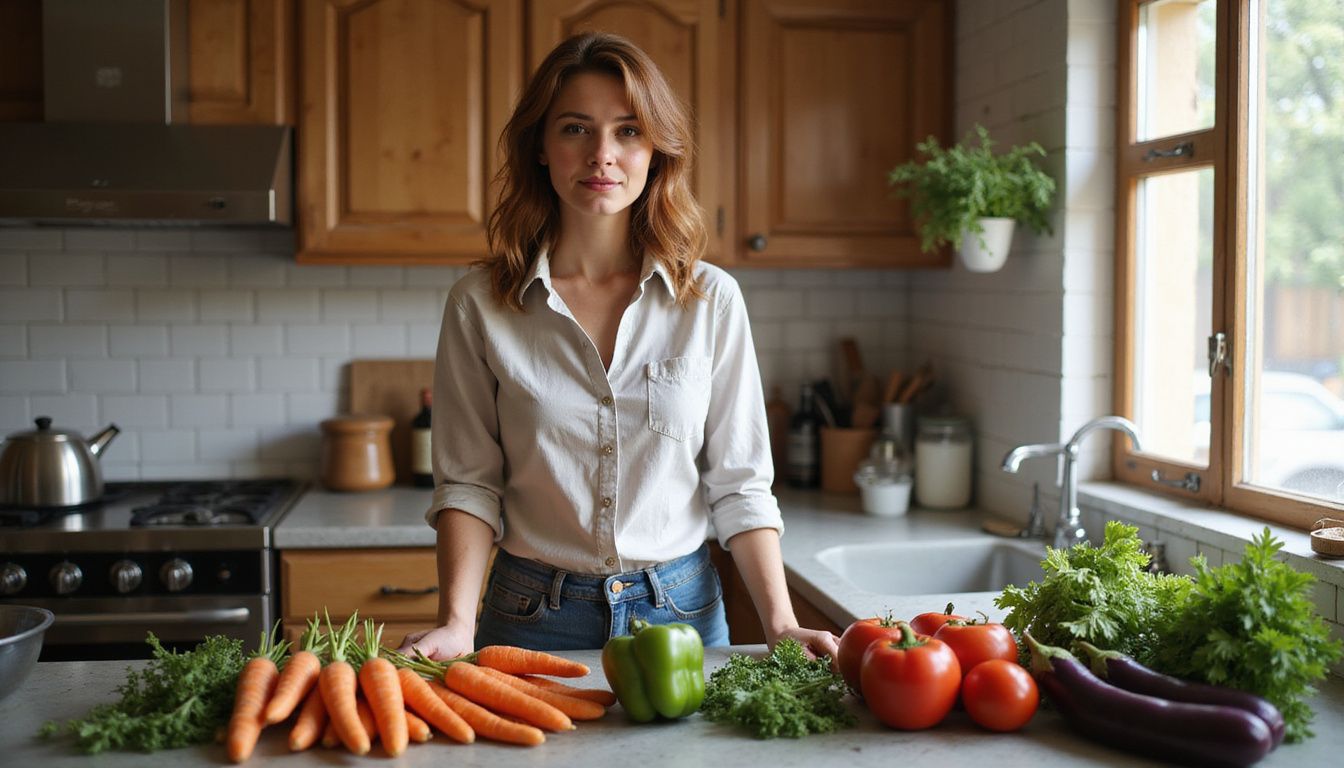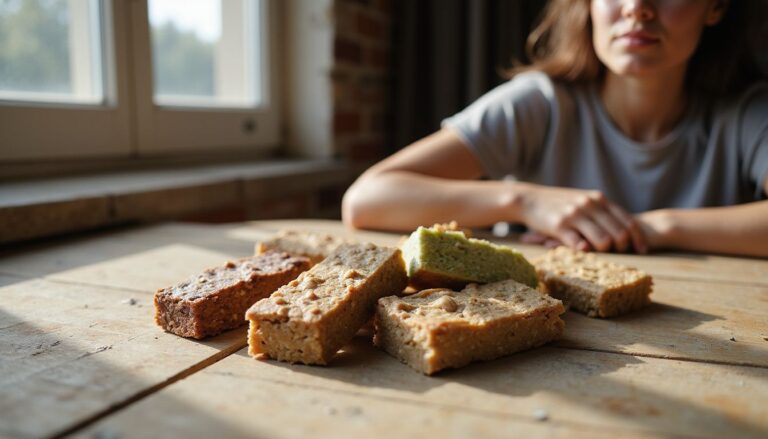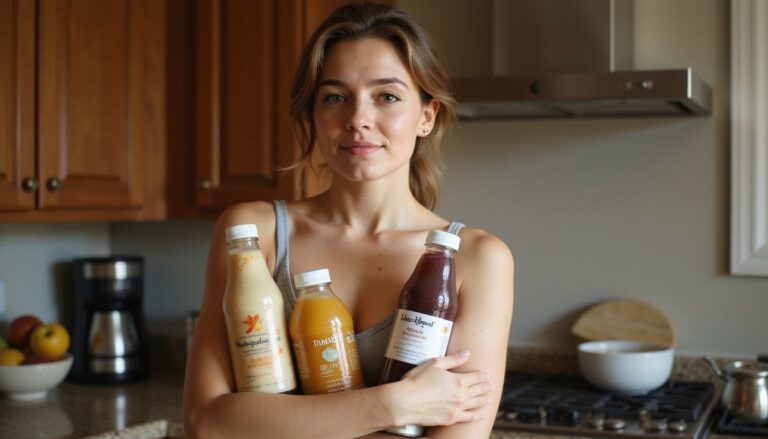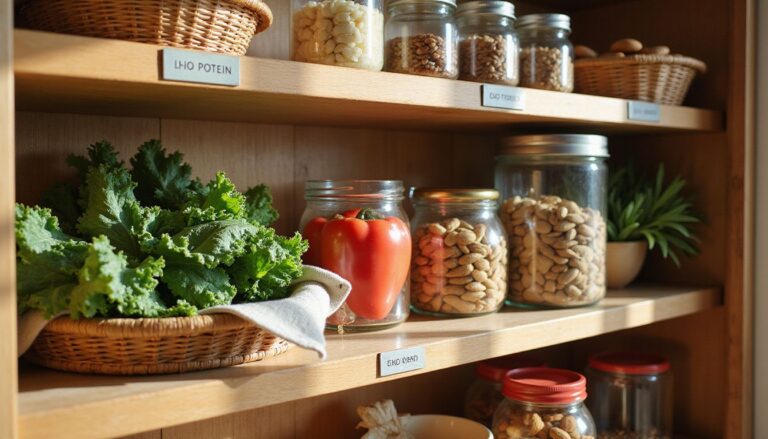Effective Vegetarian Diet Plan For Weight Loss: Meal Plan, Food List, And Tips
Our Nutrition Assistant AI Suite will transform your body. You will lose fat, get toned, and build muscle. Gain confidence and optimal health.
Losing weight on a vegetarian diet can feel confusing. You might wonder what to eat, what to limit, and how much you need. A well planned vegetarian diet for weight loss can lower your risk of heart disease and certain cancers, according to recent research.
This guide gives you simple steps, food lists, and a practical meal plan for weight loss. You will learn which foods fill you up, how to control portions, and how to build a week of balanced meals.
Key Takeaways
- Plant-based meals that are rich in fiber can lower calorie intake and may reduce heart disease risk, based on 2023 research.
- Focus on whole grains, beans and lentils, leafy greens, tofu, nuts, and seeds. Keep processed vegetarian foods limited to avoid hidden sugar, salt, and excess calories.
- Portion control matters. Even healthy foods like nut butter or rice can add up if servings are large.
- A balanced 7-day vegetarian meal plan often targets 1,200 to 1,500 calories per day, about 50 grams of protein, and at least 30 grams of fiber.
- Regular exercise, at least 150 minutes per week per CDC guidance, plus support from a registered dietitian, helps you keep weight off long term.
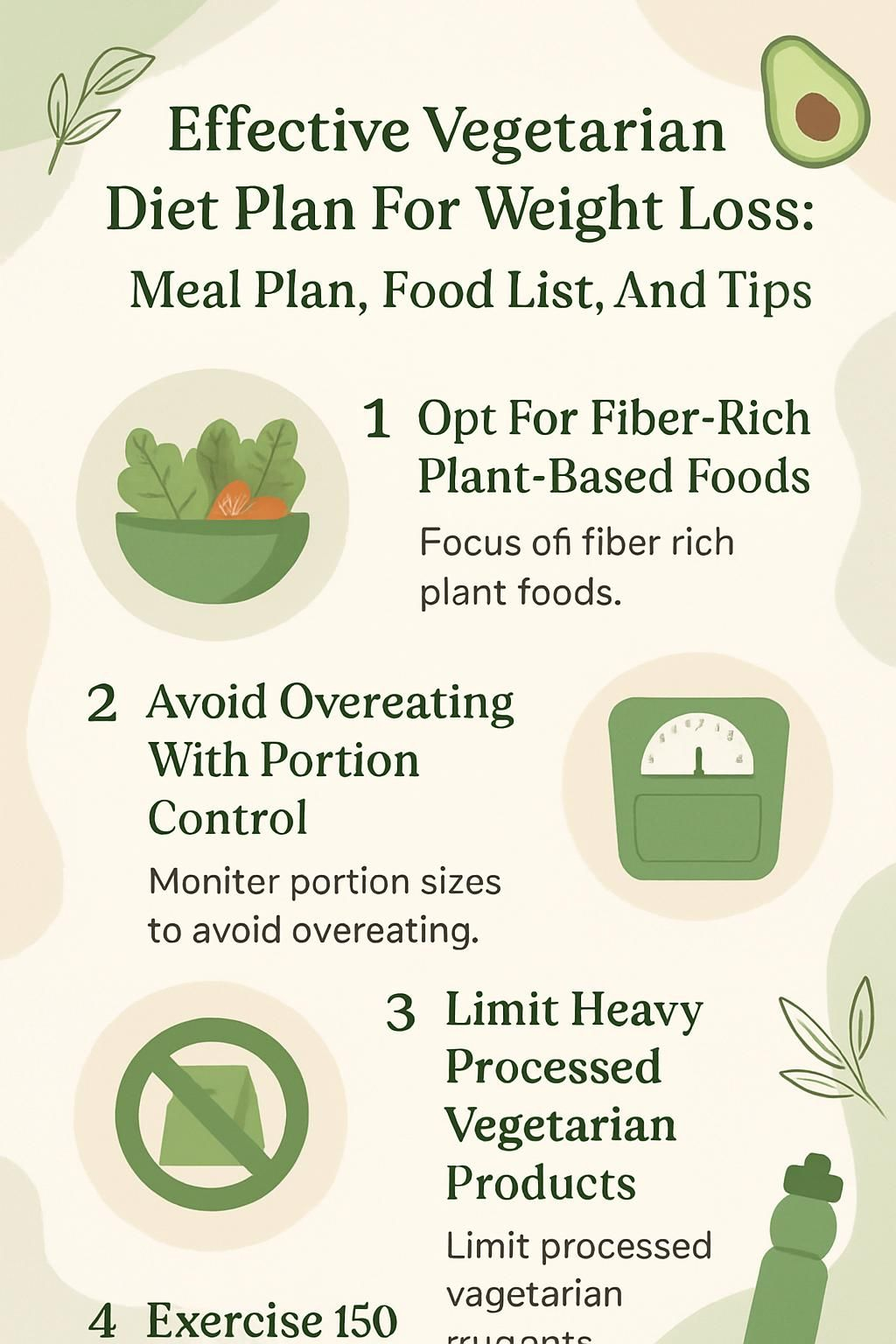
What Is a Vegetarian Diet?
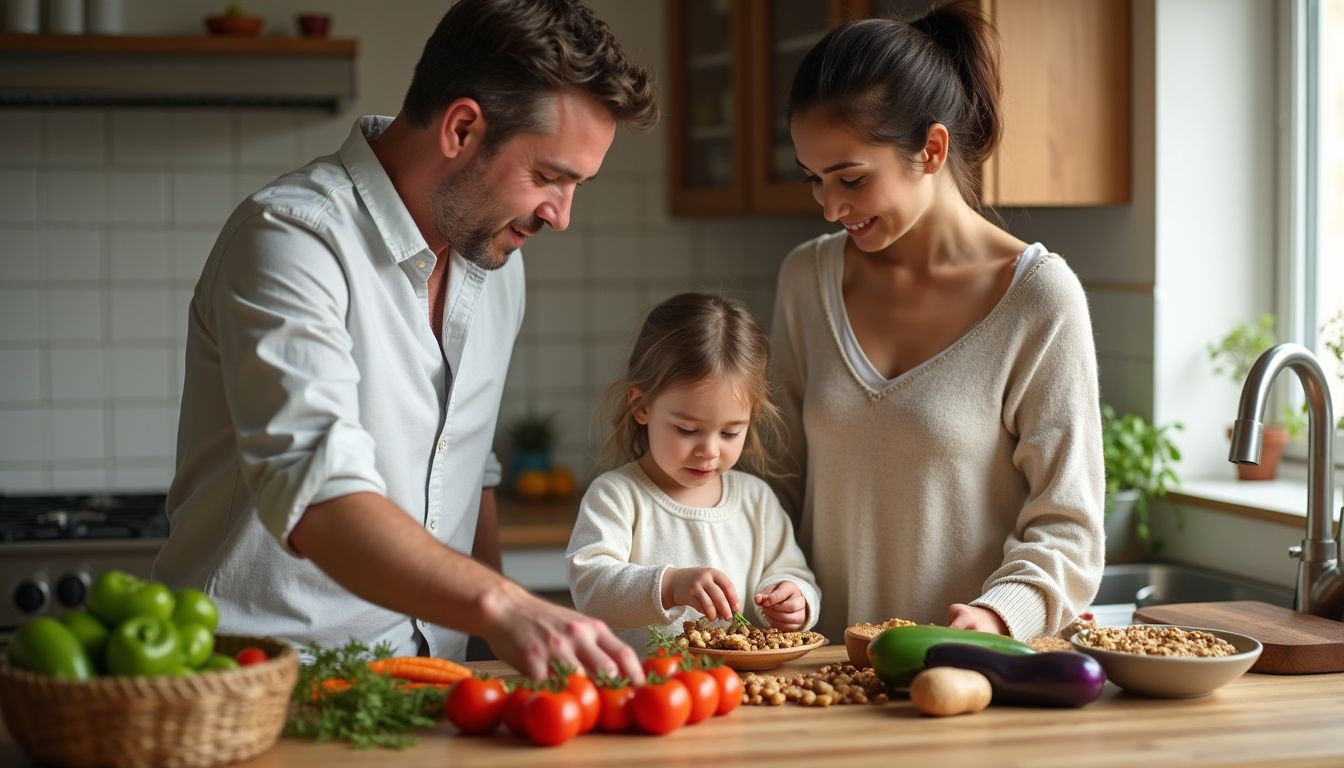
A vegetarian diet excludes meat, poultry, and fish. It includes plant-based foods such as vegetables, fruits, whole grains, beans, lentils, nuts, and seeds. With smart planning, you can meet your nutritional needs and enjoy many health benefits.
What are the main types of vegetarian diets?
People choose a vegetarian meal plan for weight, health, and ethical reasons. The main styles differ in which animal foods are included.
- Lacto-ovo-vegetarian: You include dairy products and eggs. You avoid meat, fish, and poultry. This is common in Western countries.
- Lacto-vegetarian: You include dairy. You avoid eggs, meat, fish, and poultry. Many Indian diet plans follow this style.
- Ovo-vegetarian: You include eggs. You avoid dairy, meat, fish, and poultry.
- Vegan: You avoid all animal products. You eat plant foods such as vegetables, fruits, legumes like lentils and edamame, whole grains like oats and rice, nuts, seeds, tofu, and tempeh. Honey is also avoided.
- Flexitarian: You eat mostly vegetarian meals and sometimes include eggs or dairy. This style offers flexibility.
- Pescatarian: You include fish with plant foods. Some people also include eggs and dairy.
Each style can meet your needs for protein, calcium, omega-3 fatty acids, and fiber. Vegans may need fortified foods for vitamin B12, since B12 is found in animal products.
How Does a Vegetarian Diet Help with Weight Loss?
A vegetarian diet can help you lose weight by centering your meals on high fiber, nutrient-dense foods. These foods keep you full on fewer calories.
Why is fiber important for feeling full?
Dietary fiber is the part of plants that your body cannot fully digest. It absorbs water and expands in your stomach. That helps you feel satisfied on fewer calories.
High fiber foods include beans, whole grain bread, oats, berries, and leafy greens. Fiber also slows digestion, which steadies blood sugar and lowers hunger later.
Clients who choose fiber-rich meals tell me cravings drop and portions feel easier to manage.
Eating enough fiber each day is a simple way to curb hunger and support steady weight loss.
Which nutrient-dense foods support weight loss?
Non-starchy vegetables are your best friend. Broccoli, bell peppers, cauliflower, zucchini, mushrooms, tomatoes, eggplant, carrots, celery, and cucumber are low in calories and high in fiber.
Whole fruits like berries, apples, and oranges provide vitamins and antioxidants with natural sweetness. Beans and lentils supply plant-based protein to help maintain muscle. Whole grains such as quinoa, brown rice, and barley add lasting energy through complex carbohydrates.
This mix aligns with Mediterranean diet principles and supports heart health along with a lower body weight.
How does a vegetarian diet lower saturated fat intake?
You naturally reduce saturated fat when you replace meat and butter with plants, olive oil, avocado, and nuts. For example, a cup of cooked black beans has about 0.1 grams of saturated fat. A cup of cooked ground beef has about 7.6 grams.
Choosing plant oils and skipping rich sauces can lower cholesterol. That lowers your risk of cardiovascular disease and supports weight control.
How does this diet support long-term weight management?
Whole plant foods tend to be high in fiber and lower in calories. They help you feel full, which makes it easier to stick with your plan.
A 2023 review found that people who eat more plant protein often lose more body fat. Lentils, soybeans, and tofu help preserve muscle while you lose weight. Cooking most meals at home gives you control over sugar, salt, and fat, which supports lasting results.
When I swapped packaged snacks for simple bean and veggie bowls, my afternoon hunger faded, and my progress sped up.
Common Challenges in Losing Weight on a Vegetarian Diet
Vegetarian eating can be healthy and satisfying. Still, a few common hurdles can slow your progress if you do not plan for them.
How can large portion sizes affect weight loss?
Big portions, even of healthy foods, can push you over your calorie needs. Extra calories lead to weight gain over time.
One cup of cooked brown rice has about 215 calories. Double that without noticing and you may overshoot your daily goal. Watch servings of peanut butter, avocado, cheese, and grains. Smaller portions make habits stick.
Why should you limit refined carbohydrates?
Refined carbohydrates like white bread, pasta, bagels, and crackers have little fiber. They digest fast, cause a quick rise in blood sugar, and leave you hungry again soon.
Frequent spikes can increase insulin, a storage hormone. That makes fat loss harder. Choose whole grains such as oats, brown rice, and whole wheat bread to improve fullness and support stable energy.
What are high-calorie plant-based foods to watch out for?
Some plant foods are calorie dense. Keep portions in check so they help, not hinder, your plan.
- Nut butters: Two tablespoons of peanut butter have about 191 calories.
- Avocado: One medium avocado has about 234 calories. Use thin slices.
- Cheese: One ounce has about 113 calories. Portions matter.
- Nuts and seeds: One small handful adds up quickly.
- Plant oils: About 120 calories per tablespoon. Drizzle lightly.
- Vegan desserts: Often high in sugar and refined flour.
- Processed meat substitutes: Can be high in fat, starch, and sodium.
- Dried fruit: A quarter cup of raisins has about 108 calories, mostly from sugar.
- Granola: Often includes sweeteners and oil that raise calories fast.
Last year I leaned too hard on nut butters and granola bars. Measuring portions put me back on track without giving them up.
How do processed vegetarian foods impact weight loss?
Many packaged vegetarian foods contain added sugars, refined starches, salt, and additives. These products are easy to overeat and often lack fiber.
Some meat alternatives top 400 calories per serving with high sodium. Choose them sparingly. Base most meals on whole foods so you stay full longer and support your goals.
How Can You Lose Weight Effectively on a Vegetarian Diet?
Success comes from three habits: choose whole foods, hit your protein needs, and manage portions. Add regular activity for a strong finish.
Why focus on whole, unprocessed foods?
Whole foods provide more nutrients and fiber per bite. Leafy greens, berries, legumes, whole grains, and a small amount of nuts make meals satisfying without excess calories.
These choices also limit added sugar and additives found in many snacks and boxed meals. On my own vegan weight loss meal plan, swapping pastries and cereal for a lentil stew and a banana smoothie made a clear difference within two weeks.
What are good plant-based protein sources?
Getting enough protein helps protect muscle and keeps you full. Mix and match these options through the week.
- Beans and lentils: About 15 to 18 grams per cooked cup.
- Tofu and tempeh: Around 10 to 20 grams per half cup. Great in stir-fries and salads.
- Edamame: One cup provides about 17 grams of protein.
- Nuts and seeds: About 5 to 8 grams per ounce. Measure portions.
- Greek yogurt: Up to 20 grams per cup if you include dairy.
- Eggs: About 6 grams per large egg for ovo-vegetarians.
- Milk: About 8 grams per cup. Choose low-fat if you include dairy.
Building each meal around one protein source makes it easier to meet daily needs.
How important is portion control?
Portion control shapes your calorie balance. Healthy foods still add up if servings are large.
Many weight loss diets aim for 1,200 to 1,500 calories per day. Measure high calorie items like nuts, cheese, and hummus. One ounce of nuts has roughly 160 to 200 calories. Small scoops help you stay in range without feeling deprived.
How does physical activity aid weight loss?
Exercise burns calories and helps preserve muscle. That boosts your resting metabolism, so you burn more even when you sit.
The CDC recommends at least 150 minutes of moderate activity per week. Brisk walking, cycling, swimming, or yoga pair well with a vegetarian meal plan. People who move regularly tend to lose more weight and keep it off.
I like a 30-minute walk after dinner. It helps digestion and keeps my evening snacking in check.
Which Vegetarian Foods Promote Weight Loss?
Think of your plate as a triangle. Fill half with vegetables, one quarter with whole grains, and one quarter with protein.
Why include leafy greens?
Leafy greens like spinach and kale are low in calories and high in fiber. A cup of raw spinach has about 7 calories and provides vitamin K, iron, and folate.
Greens add volume to meals, which helps you feel full. A 2016 study found that dietary nitrates in greens can also support blood vessel health.
I add a handful of spinach to omelets or smoothies for an easy nutrition boost.
How do legumes and lentils help?
Beans and lentils bring protein and fiber in one package. A half cup of cooked lentils has about 9 grams of protein with very little saturated fat.
Regular intake links to lower cholesterol and better heart health. You can add chickpeas to salads or enjoy dal with brown rice for a balanced meal that keeps you full.
What role do whole grains play?
Whole grains such as quinoa, brown rice, millet, farro, barley, and bulgur digest slowly. They steady blood sugar and help prevent cravings.
For example, one cup of cooked quinoa offers about 5 grams of fiber. White rice has less than 1 gram. Choosing whole grains supports long-term weight control by improving satiety and energy.
Can nuts and seeds support weight loss?
Almonds, walnuts, pistachios, cashews, sunflower seeds, and chia seeds offer healthy fats, fiber, and protein. They can reduce cravings and improve fullness.
One ounce usually has 160 to 200 calories, so measure servings. Small amounts are linked to better weight outcomes over time. Try berries with sliced almonds or chia seeds stirred into yogurt.
Why eat tofu and tempeh?
Tofu and tempeh provide lean plant protein. Tofu has about 8 grams of protein per 100 grams, while tempeh has about 19 grams per 100 grams.
They are lower in saturated fat than many dairy choices. Higher protein meals help you feel full and protect muscle while losing weight. I swapped paneer for tofu in a favorite curry and cut calories without losing flavor.
What Foods Should You Avoid on a Vegetarian Diet for Weight Loss?
Some foods make it harder to reach your goals. Keep these in check to protect your calorie budget and energy.
Why limit sugary snacks and desserts?
Candy, cookies, pastries, soda, fruit juice, energy drinks, and sweet tea add calories fast and do not satisfy hunger. A 12-ounce soda has about 39 grams of sugar and more than 140 calories.
These foods create spikes and crashes that trigger cravings. Cutting back reduces empty calories and makes room for nutrient-dense meals.
What’s wrong with refined grains and breads?
White bread, white pasta, bagels, and many crackers are low in fiber. They digest quickly and leave you hungry soon after eating.
Frequent use can raise calorie intake across the day. Whole grain versions keep you full longer and support weight control.
How do fried foods affect weight loss?
Fried foods are calorie dense and high in unhealthy fats. A single serving of deep-fried snacks can exceed 300 calories with 20 grams of fat or more.
Eating fried items often is linked to higher body mass index and weaker long-term weight control. Baking, air frying, or roasting gives you crunch with fewer calories.
Why avoid processed vegetarian products?
Packaged veggie burgers, fake meats, vegan desserts, and many frozen meals can be high in sugar, salt, and saturated fat. Some meat substitutes carry more sodium than a fast-food burger.
Relying on these products can stall progress. When I shifted my 7-day vegetarian meal plan toward beans, grains, and vegetables, I stayed full longer on fewer calories.
Sample 7-Day Vegetarian Meal Plan for Weight Loss
Use this sample week to guide portions and balance. Adjust for your calorie needs and preferences.
What does Day 1 include for a balanced start?
Breakfast provides 318 calories and steady energy. A morning snack adds 103 calories to keep hunger in check. Lunch offers 343 calories with a balance of protein, carbs, and healthy fat.
Enjoy a light 30-calorie snack in the afternoon. Dinner features Roasted Vegetable and Black Bean Tacos for 343 calories, rich in fiber and plant protein. An evening snack adds 78 calories.
Daily totals are about 1,214 calories with around 50 grams of protein, 143 grams of carbs, 33 grams of fiber, about 57 grams of fat, and roughly 967 milligrams of sodium.
How does Day 2 provide nutrient-rich meals?
Start with whole wheat toast and avocado for fiber and healthy fat. Choose fresh berries or a small portion of nuts for snacks.
Lunch lands near 346 calories, often a hearty bean or lentil salad. Dinner is the most filling at about 496 calories. The day totals about 1,180 calories with roughly 53 grams of protein while keeping sodium under 2,000 milligrams.
What high-fiber foods are on Day 3?
Day 3 centers on vegetables like bell peppers, zucchini, and carrots plus quinoa for fiber. The day reaches 30 grams of fiber.
Total calories sit near 1,200 with about 113 grams of carbs and many vitamins from plants. High-fiber meals keep you full without relying on added sugars or processed snacks.
How are healthy fats incorporated on Day 4?
Healthy fats improve satisfaction and support heart health. Add almonds or chia seeds to snacks. Use olive oil to roast or sauté vegetables.
Spread a thin layer of nut butter on whole grain toast. Top salads with avocado slices instead of creamy dressings. I began adding avocado to wraps, and it kept me satisfied until dinner.
What light but filling dishes are on Day 5?
Breakfast is about 252 calories. Two light snacks add about 30 and 115 calories. Lunch has around 320 calories and balances plant protein with fiber.
Dinner features collard greens or kale sautéed with tomatoes and curry powder, about 420 calories. Daily totals are close to 1,215 calories with about 80 grams of protein, 131 grams of carbs, 32 grams of fiber, and about 1,530 milligrams of sodium.
How does Day 6 include protein-packed meals?
Day 6 keeps total calories near 1,214 with about 50 grams of protein. Include eggs at breakfast if you eat them, beans at lunch, and Greek yogurt for a snack if dairy fits your plan.
Use tofu or tempeh at another meal. Planning ahead makes it easier to feel full between meals and hit your protein target.
What plant-based variety is offered on Day 7?
Day 7 highlights whole grains, legumes, and seasonal vegetables. Breakfast has about 318 calories from fiber-rich grains. Lunch adds 320 calories with beans or lentils and fresh vegetables.
Snacks total about 196 calories, usually fruit or raw vegetables. Dinner comes in at 361 calories, pairing hearty plant protein with colorful produce. Daily totals approach 1,200 calories with roughly 60 grams of protein, 42 grams of fiber, 46 grams of healthy fat, 1,482 milligrams of sodium, and about 157 grams of carbs.
Additional Tips for Sustainable Weight Loss on a Vegetarian Diet
Small, steady habits beat short bursts of effort. These tips make the plan easier to live with day to day.
How can meal prep help your weight loss?
Meal prep keeps healthy choices front and center. Make Roasted Vegetable and Black Bean Tacos ahead so dinner is ready on busy nights.
Boil a batch of eggs for quick protein. Freeze portions of lentil soup for later. A 2017 study in the International Journal of Behavioral Nutrition and Physical Activity linked meal planning with better weight outcomes.
Why is staying hydrated important?
Water supports metabolism and can reduce overeating, since thirst can feel like hunger. Try water, seltzer, fruit-infused water, or plain tea and coffee.
Drinking 16 ounces before meals can help you eat fewer calories. I keep a lemon water bottle nearby, which cuts snack cravings in the afternoon.
Why avoid overeating even healthy foods?
Nuts, seeds, and avocados are nutritious, yet calorie dense. Large portions can erase your calorie deficit.
For example, one ounce of almonds has about 160 calories. Keep servings modest so your body can tap stored fat for energy.
How to monitor your progress effectively?
Track your meals, water, and activity with a notebook or a free app. People who log their meals often lose more weight than those who do not.
Weigh yourself at the same time each week. Review portion sizes if progress stalls. Switching some starchy vegetables to leafy greens helped me break a plateau in two weeks.
Conclusion
Choosing a vegetarian diet for weight loss can be a smart, sustainable path. Center your plate on vegetables, fruits, whole grains, beans, lentils, tofu, and tempeh. These nutrient-dense foods deliver fiber and steady energy while helping you stay within your calorie goal.
Limit processed items, sugary snacks, and refined grains. Watch portions of calorie-dense foods like oils, nuts, and cheese. Pair your meal plan with regular exercise for better results. If you have medical conditions or special needs, talk with a registered dietitian or your healthcare provider for personalized guidance.
- Evidence snapshot: Plant-forward patterns support weight loss and heart health in recent reviews from 2023.
- CDC: Adults should aim for at least 150 minutes of moderate activity each week.
- Ultra-processed foods are linked with higher obesity risk in multiple studies from 2021 and later.
FAQs
1. What foods should I include in a vegetarian diet plan for weight loss?
A balanced vegetarian meal plan for weight loss should feature lentils, beans, tofu, leafy greens, whole grains like brown rice and oats, nuts in moderation, and fresh fruits. These options provide protein, fiber, vitamins, and minerals while keeping calories controlled.
2. How can I make sure my vegetarian diet supports healthy weight loss?
Choose high-fiber foods such as vegetables and legumes to help you feel full longer. Limit processed snacks and sugary drinks. Track your portion sizes using a food diary or app to avoid overeating even with plant-based meals.
3. Are there any risks linked to following a vegetarian diet for losing weight?
Research shows that well-planned vegetarian diets are safe for most people when they supply enough protein, iron from sources like spinach or fortified cereals, vitamin B12 supplements if needed, calcium from dairy alternatives or seeds like chia seeds; and omega-3s from walnuts or flaxseeds.
4. Can you share an example of a daily meal plan on this type of diet?
A sample day could start with oatmeal topped with berries at breakfast; lunch might be a chickpea salad with mixed greens; dinner could feature stir-fried tofu with broccoli over quinoa; snacks may include carrot sticks or Greek yogurt made from soy milk if dairy is avoided.
Summary: A successful vegetarian diet plan for weight loss uses nutrient-rich foods such as pulses and vegetables while limiting processed items. Careful planning ensures all nutritional needs are met without excess calories according to current research findings.

